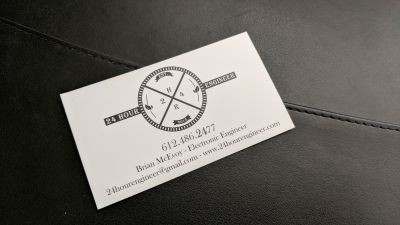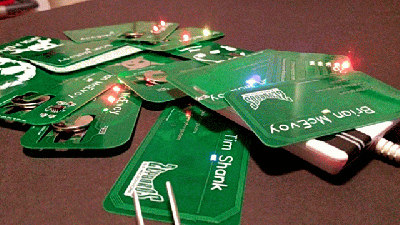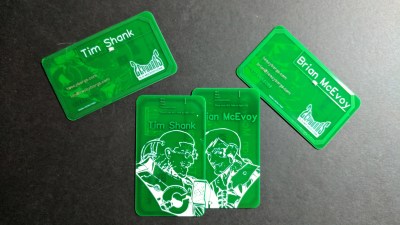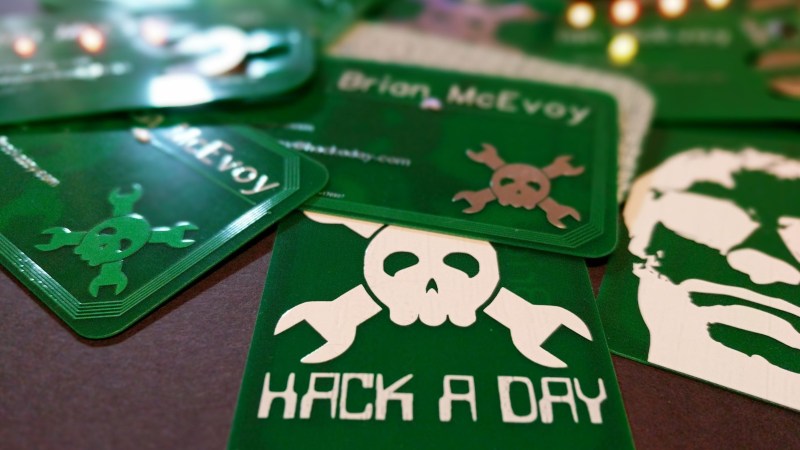Business cards are stuck somewhere between antiquity and convenience. On one hand, we have very convenient paperless solutions for contact swapping including Bluetooth, NFC, and just saying, “Hey, put your number into my phone, please.” On the other hand, holding something from another person is a more personal and memorable exchange. I would liken this to the difference between an eBook and a paperback. One is supremely convenient while the other is tactile. There’s a reason business cards have survived longer than the Rolodex.
Protocols and culture surrounding the exchange of cards are meant to make yourself memorable and a card which is easy to associate with you can work long after you’ve given your card away. This may seem moot if you are assigned cards when you start a new job, but personal business cards are invaluable for meeting people outside of work and you are the one to decide how wild or creative to make them.
The Origin of Blinky Cards
My first round of business cards were designed by a good friend and printed on dead trees. As an engineer, I accepted my own lack of style (cargo shorts FTW) long ago.
good friend and printed on dead trees. As an engineer, I accepted my own lack of style (cargo shorts FTW) long ago.
Her design was incredible and I bragged about having cards that were a bit unique and a bit traditional. Most often, they were actually an ice-breaker more than a way to wrap up a conversation. They were also a handy place to write notes and subtly give people my blog address at the same time.
Making yourself memorable through a business card can take a few forms. The first way is to be so memorable at your meeting that people can’t help but remember you when they see your name. The second way, give them a card that is so stylish they will remember you as you are mirrored in your card. The last way, which is what I’ll cover, is to give them a card so far outside their expectations that your face will be burned into their mind the moment your card touches their hands.
Flashing Takes Power: The Cutout Battery Holder Trick
Inspiration for my take on PCB business cards came from the idea of having a (literally) flashy card. After a little hunting, the biggest problem seemed to arise from a power source. Some relied on USB power and some had a battery soldered into the heart of the card. I wanted something that was more portable than USB power and more replaceable than a soldered battery.
The hack was to use the flexible nature of 0.6mm PCBs as the battery holder itself. A coin cell can be slipped in and out of these “fingers” easily. The profile of the whole card is thinner than a typical battery holder and it doesn’t even appear on the BOM. Plus, coin cell holders are prone to catching on the inside of pockets.
It was tempting to use a microcontroller to flicker some LEDs but “You can do that with a 555.”
Power Your Business Card Out of Thin Air
Powering a card with USB isn’t a bad way to go but  it requires a card 2.4mm thick and that is far from the only way to power up. You could add 9V battery snaps or even carve out two semi-circles at the edge of the card where 9V battery terminals can make their connections.
it requires a card 2.4mm thick and that is far from the only way to power up. You could add 9V battery snaps or even carve out two semi-circles at the edge of the card where 9V battery terminals can make their connections.
Another concept I experimented with was to harvest the power from an NFC transmitter. This card served the purpose of becoming an NFC antenna finding tool. Unlike similar tools, this simple design wouldn’t differentiate between high and low-frequency transmitters but the BOM only requires an LED. So, simplicity over function in a giveaway.
The Budget Card: Do You Even Blink?
With the plummeting cost of PCBs and the rocketing number of respectable design apps, this was a natural intersection. Designing PCBs has never been easier with all the Benchoff tutorials here and maybe some new tips you can pick up from this article. Express your creative side on top of your engineering skills with a beggar’s budget.
PCB business cards don’t have to have electronics, they can simply be a way to show people  you are familiar with EDA software. Some people use unpopulated footprints as a guide for selecting parts.
you are familiar with EDA software. Some people use unpopulated footprints as a guide for selecting parts.
Factors to consider when designing your card hinge on many things, most often, the cost will be at the top of the list. Compared to the dead-tree business cards, these are monstrously expensive. Handing out a PCB card to a crowded room would be costly but if you want to impress the hell out someone a hand-soldered business card might be the ticket.
A business card can tell you a lot about a person. Someone with rainbow comic sans probably shouldn’t design your company’s logo but could be a wonderful babysitter. Someone with cards printed at home on an inkjet printer wouldn’t be my first choice for long-term financial investments but might be my specialty paper supplier. Someone with a water-logged clump of paper probably isn’t VP material but might your best bet for a plumber. Show those lucky enough to be handed a PCB instead of your paper card that you have a knack for electronic design and a tinge of style to boot.
PCB tutorials by Brian Benchoff are a phenomenal place to start making your own or check out a technique for full-color cards. Using a microcontroller in your business card can look sexy but you can fit a whole EKG there if you really want inspiration.


















Let’s hear more about the NFC version – nearly every office/home has a WiFi router it seems so this might be a lot of fun.
1++
This card is a detector which can show the location of the NFC field so it should help you pinpoint where your router/printer/scanner keeps their antenna. Some of them use low-frequency RFID which isn’t as reliable with these cards.
Here is more information I wrote about the NFC detecting cards
http://www.24hourengineer.com/2017/09/2017-09-26-tu-electronic-business-card.html
If you want to do some more in-depth hacking with the RFID in your devices, check out scanlime’s article.
http://scanlime.org/category/projects/rfid/
Thanks,
I just noticed on the webpage a sidebar for a $1 donation, but when I followed the “First Time Here” link, it says donations will not be given.
No complaint here, just thought you might want to do an edit.
Nicely spotted. I added the donate button when I removed the ads.
I made one recently (posted about it two daya ago on my site) : http://smdprutser.nl/blog/pcb-businesscard-nextgen-nfc-enabled/
It basicly uses a off-the-shelf NFC eeprom that has an energy harvesting circuit in it. That powers a micro that changes the contents of that eeprom depending on the button that was pressed.
The squiggle traces for the buttons,
I’m guessing that is to add resistance to determine which button is pressed?
Nope. They are just there because i could :) tried to make it look less nerdy
The micro has plenty of inputs available.
WiFi has nothing to do with NFC. NFC is 13MHz or 125 kHz, which is quite easy to rectify as power source. This gets much more difficult in the GHZ range(2,45GHt or 5GHz) of WiFi.
Everyone be like… “Ima steal that battery clip tho…”
Yep!
I can’t help but feel like it would last longer if you used a CR2016 instead of a CR2032, but yeah, damned clever design.
I generally prefer the CR2032 because they seem more widely available locally for when your battery is dead and you need one right now.
A CR2016 will last longer than a battery twice as thick (1.6 mm v. 3.2 mm)?
No, the card would last longer, due to flexing it half as far. (Though I don’t think it will be a problem either way.)
BTW you know you’re not getting any sleep for the next 2 weeks if that’s your number because of all the thousands of readers thinking they’re the unicorn funnyman to test out the 24 hour claim…
If you want to get really fancy, use an ultra efficient LED combined with a supercap and that RF-energy harvester. The card would be charged up when near any wireless “hot spot” and keeps on working for a while even if there are no powerful RF sources near. I guess at some point you have to ask yourself how much the BOM of your businesscard should cost, i’d say cost and thickness of the complete assembly are the only two limiting factors.
I like your idea, but do they make real thin supercaps? (you know, for a business card)
They do. A quick google turned up these guys:
https://www.cap-xx.com/products/photo-gallery/
Thanks!
At least there are very thin (sub mm) LiIon batteries with some mAh of capacity, but very expensive. But Energy harvesting of WiFi (<100mW of GHz power) is not very useful.There were this Blink-LED Gadgetss for the Antenna of GSM (2G, 900MHz) phones but they did 2W of TX-power.
Another option, QI wireless chargers.
You only need a PCB trace coil, and 2 LEDs (anti-parallel) across the coil and they will blink. :D
I demonstrate it at the beginning of this video:
https://youtu.be/kgYtYXVkan0
I never thought of making this into a business card until this article, and with the iPhone now using wireless chargers they should start showing up everywhere.
Just place the business card on the charging spot at the coffee shop, and blinking begin. :)
I use a QR code. Has everything in it. Once you receive it, really simple to add it to your address book.
An E-Ink business card has possibilities.
Been looking into that but they are still too darn expensive for giveaways. :(
I have a hatred of unnecessary landfill. Sorry to be a killjoy, but if you gave me one of these, I’d hand it straight back and probably wouldn’t take you up on your business offer either.
I would let you scan my NFC implant (left yand) for paperless contact information.
Nice, shame it’s affected your ability to type tho.
Haha, I should proofread my comments, eh?
… but at least you can upcycle the cardboard ones as roaches right?
I really like the built-in battery holder. That’s ingenious.
I’d like to see it capture the battery a little better, maybe with a post on each end that doesn’t flex as much as the contacts and snaps into locking position once the battery is inserted. If you see something from me down the road with that, I’ll do my best to link here for my inspiration..
Seems like piezoelectric tech would be a perfect fit for this — bend the card (or squeeze it), watch it light up.
can you use the led on the card as a solar panel? i understand they ‘work’ backwards (emit electricity when given light) would that be more generative (sorry, trouble with words today) than energy harvesting?
You can indeed, in much the same manner as it being useful to use a teaspoon to shovel snow.
Are you willing to share the layout for the integral battery holder? I’m sure I can figure it out with enough trial and error but it’d be great to get a head start.
https://easyeda.com/24hourengineer/Business_Card_Simple_Color_Changing-cd8177606e8844ed80c7f61349d78cde
This should help you get started. Send me a picture of your cards when you get them, I would love to see them.
Thanks much! I’m designing a UVI (ultra violet index) monitor in card format for skin cancer awareness.
That’s awesome! You make me happy that I shared this design.
Woah I’ve never seen this before!!
How about circuit board that somehow sends a vcard via Bluetooth? Is that even possible?
That’s a good question. That would be paperless and multiple people could access it at their leisure without having to hold a physical object. Great for mass distribution.
Or Solar powered business cards, for a solar business :-D https://www.facebook.com/GreenGuysEnergy/posts/151838400062910